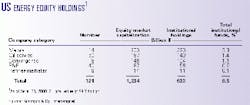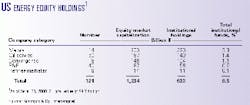Given the high energy prices and record earnings now being reported by energy companies, access to capital should improve in 2001. Yet the public equity markets remain in a volatile state and most energy companies continue to complain about languishing stock prices.
A number of public energy equity offerings, for example, have recently been reduced in size and price expectation, and some have been withdrawn altogether. In addition, bank credit for medium to small energy players remains tight.
Food for thought
Do the capital markets know something energy producers do not? Can sound energy projects be funded only by external capital as long as they are based on historical energy prices?
Should energy companies even try to rely on external capital to fund growth, or instead, should they adopt the financial discipline to live within the means of internally generated cash flows?
Is the volatility of energy pricing now so established that any significant use of debt ought to be avoided as too risky? What is the proper level of debt and equity in today's volatile energy markets?
There are no easy answers to these questions. The right answer obviously varies from company to company or according to the specifics of the project in need of finance. But there are some interesting crosscurrents creating confusion in the capital markets and uncertainty regarding where capital for energy projects should be allocated.
One could argue that such uncertainty might be a positive event, as history shows that once capital begins flowing to any sector, it will soon fuel marginal projects that ultimately leads to the excesses that sow the seeds for subsequent busts.
On the other hand, it is now believed that the energy industry faces a serious crisis due to a lack of spare energy capacity. And unless this capacity is expanded rapidly, the shortage could soon threaten the well-being of the world's economies.
Meeting this challenge will require a massive expansion of every form of energy and the rebuilding and refurbishing of the world's energy infrastructure. The cost to complete such a program could total in the trillions of dollars and take more than a decade to complete.
If this expansion and rebuilding of the energy complex is to take place, large amounts of external capital will have to be raised. Otherwise, energy prices could soar to unprecedented levels in order to create enough internal cash flow to undertake the task, with disastrous results to the economy.
It is important to understand both the vagaries of the capital markets and the ingredients that the capital market providers need before they will begin to meet the energy systems' capital needs. Finding an appropriate balance between internal cash flow, external debt, and equity is the consequent question that will only be answered on a case-by-case basis.
Attracting new capital
There are a host of reasons why capital providers now shy away from energy, despite the record earnings being reported by so many industry participants. Leading the list is the poor historical return most energy participants have earned over the past 2 decades. Despite 20 years of consolidation and downsizing, few industry participants have aligned their cost structures with low energy prices.
These returns have improved dramatically as energy prices have soared. But in the capital markets, there is no sense that current high prices will last. After all, most energy companies have publicly stated this condition will not hold, and almost all company planning is being based on energy prices soon returning to "historical norms."
From the standpoint of an outside lender or potential equity investor, this merely influences stakeholders to step aside until prices fall to the place where the historical norm is a basement, not a next-cycle ceiling. Moreover, when many new energy projects are subjected to historical norm pricing, the attractive returns suddenly disappear.
The past decade's extreme volatility in energy prices, coupled with the terrible returns at the low end of this vicious price cycle, have created a real barrier for anything but high-risk capital to fund one of the world's most capital-intensive businesses.
Can this barrier be shattered? Certainly it can, as financial memories do not last forever. But, it will take time. The energy business needs to create a multiyear track record of sustainable high profits and avoid any further boom-bust cycles.
Alternatively, energy companies need to get so lean that further energy price collapses no longer result in marginal financial returns. Then, we will certainly see capital begin flowing back to the energy sector.
But this scenario also suggests it will take years before the necessary capital becomes available. A far better solution is to alter conditions of extreme energy price volatility so as to jump start a return of sizeable capital flows into the energy business.
Absent a reform in energy prices, can the energy industry realistically break the mold of the ever-increasing violent cycles? After a decade of downsizing, is it even possible for energy companies to unlock massive new layers of cost redundancies so they can tolerate almost any price downturn? This seems most unlikely.
Ending price cyclicality
Financial planners and the energy think-tank analysts should ponder whether the industry has the ability to take better control of its pricing and smooth out the dangerous cycles. If this does not occur, the energy industry might become increasingly capital-starved. It will then be highly unlikely that a massive expansion in our energy complex will ever get under way, creating even greater price swings.
As long as the energy industry continues pricing its products based on the closing daily prices of energy contracts on the commodity exchanges, energy will continue to be a commodity whose prices swing wildly back and forth.
This pricing mechanism came close to destroying the energy industry over the past decade and has lead to financial instability in 80% of the members of the Organization of Petroleum Exporting Countries. Perhaps it is time for the industry to change how it sets energy prices. This might be the only key to freeing up the massive capital needed by the energy industry.
There has to be a better approach to pricing energy than simply letting daily energy prices swing back and forth on the whims of speculators in the commodity exchanges. It would be smart for energy players to once again begin creating long-term contracts for their energy supply with prices set high enough to create realistic, but not exorbitant financial returns.
If other industries, with products far less critical to the well-being of world economies, can figure out this financial discipline, why can't this be done for energy? For too long, the industry has simply accepted the inevitability of being a boom-and-bust business and has avoided the necessary managerial steps needed to avoid this cyclical plague.
The energy industry needs also to begin using the various financial risk-management tools for hedging as true risk-management tools (see related articles, pp. 60 and 68); instead of letting speculators be the primary recipients of these instruments to further fuel added "liquidity" and volatility to the "energy-casino" investment game.
Too many energy companies have avoided using risk-management tools to smooth out steady profits, arguing that "our shareholders want the exposure to upside risk." Unfortunately, over the past few years, fewer and fewer shareholders have wanted to play such a risky game.
Finance 101
Early on, business students are taught to finance long-term assets with long-term financing. On a similar note, short-term credit should only then be used to finance short-term needs and working capital.
Yet the energy business has walked away from long-term energy contracts, where the price for energy supply was fixed or tied to some logical formula related to the cost of the energy. By taking this step, the industry has effectively chosen to finance long-term projects with extremely short-term capital. In other words, commodity speculators using 2-min technical trading charts now set prices instead of investors using long-term energy fundamentals.
More than any other mistake made over the past 30 years, this mistake has led to poor financial returns with such side effects as continuous downsizing. As a result, the energy industry has become a shadow of its previous self as the financial community continues to shy away from this market.
A decade of "paper-barrel" energy prices has left the industry dependent on high-risk investors who now form the sole source of capital. This financial environment has created a world where energy prices can easily triple or quadruple. As a result, the energy industry has failed to expand its capacity. The risks involved were simply too great.
A decade of low average energy prices also ensured that new energy capacity would not be added while low prices fed steadily increasing energy demand.
This surge in demand has consumed almost all the world's spare energy capacity for oil, natural gas, and electricity. The wild rise in natural gas prices and the rolling brownouts throughout the US electricity grid are both symptomatic of an energy system with no spare capacity.
Financial reform
Yet if this industry can change how it sets the price for energy, an era of steady, attractive financial returns will return.
Consider the added flow of funds that energy can attract. In the current US financial markets, institutional investors have invested almost $10 trillion in equities alone. In the most recent financial disclosures, only 6.5% of these funds are invested in the energy complex.
If the 14 companies listed as major integrated oil and gas companies are excluded, the rest of the E&P companies, the energy-convergence companies, the refiners, and the entire oil service sector represent only 3.2% of this entire $10 trillion. By contrast, at the end of 1980, the energy sector represented almost 30% of these same institutional investors' funds (see table).
A shift of just 10% of the institutional investor equity funds would triple the funds invested in the energy sector. Obviously such a move would enhance the stock prices of most energy companies. It would also set the stage for financing the expansion of the world's energy capacity and the rebuilding of the existing energy complex.
Attracting capital
It is within the industry's ability to reform how it prices its product. A decade of trying to cope with wild energy price swings through cost-cutting proved unsuccessful. Making such a change will not be easy, but the alternative is so unattractive that any amount of work will be well worth the effort.
The payoff for creating a safer, more-predictable energy price environment will not only be the removal of barriers to capital access. It will also usher in an era of far higher equity valuations for energy companies.
The stock market has its own volatility, but certain financial traits rarely change. Steady and predictable financial performance is always rewarded in the financial markets. It is the only sure-fire way to attract new equity and debt.
As volatility disappears and returns become more predictable, the cost of capital will also be driven down. Multiple financing options will begin to open up to the capital-hungry energy industry.
The energy business experimented with pricing its product on the spot market, based on the daily swings of energy contracts in the commodity exchanges for the last 2 decades. The experiment failed, and it is now time for a change. If we make this change, the rewards will be substantial.
The author
Matthew Simmons is president of Simmons & Co. International, a specialized energy investment-banking firm that has completed over 400 investment banking projects at a combined value of $55 billion. He graduated cum laude from the University of Utah and received an MBA with Distinction from Harvard Business School. Simmons serves on the board of directors of the Associates of Harvard Business School and is a past President of the Harvard Business School Alumni Association. He also serves on the board of directors for Kerr-McGee Corp., Houston Technology Center, and the Harbor Branch Oceanographic Institute.




